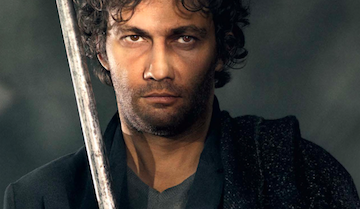
By Colleen Chesterman
And so it came to pass ... for 3 nights in August the Sydney Opera House Concert Hall was filled with enthusiastic audiences watching and listening to Wagner’s last and most cerebral opera, with its extraordinary music. Although the audiences were undoubtedly drawn by the presence of highly praised German tenor Jonas Kaufmann, the performance delivered much more. I and Michael Chesterman were fortunate to have seats in the centre of the third row, close to the singers, even if the surtitles were blocked. We found we were next to friends just returned from three months in Europe. We heard from others with seats further back and in the gallery that the sound was sometimes unsatisfactory. But this was not our experience.
Major praise must go to conductor Pinchas Steinberg. He controlled the Australian Opera Orchestra with delicate gestures and coaxed a wonderful depth of sound. The orchestra responded brilliantly, freed from the constraints of the Opera Theatre’s cramped pit accommodation. Also liberated to produce thrilling singing were the forces of the Opera Australia Chorus, behind the orchestra in the choir stalls. It was a magnificent achievement by both groups.
The first and third acts were dominated by splendid singing by Kwangchul Youn as Gurnemanz, in his narration of the damage afflicting the Knights of the Holy Grail. His rich bass expressed sorrow and pity at what had befallen his community. We had seen him at Bayreuth in the famous Stefan Herheim production, but the complexity of the narratives and symbols in that production did not give Youn the same space to depict his wisdom and sadness as did this concert version.
The title role is a signature one for Jonas Kaufmann: his beautiful voice and expressive delivery establish a significant benchmark. He movingly conveyed Parsifal’s simplicity and his difficulty in understanding how he has offended by killing the swan. His confusion in responding to the temptations of Kundry’s kiss was also well shown. His assumption of the role of saviour of the community at Montsalvat was also movingly portrayed.
Michelle de Young as Kundry was somewhat disappointing, her high notes sometimes piercing; at times there was a harsh quality in her voice. In the first act, however, her voice was richly portentous and coloured and in the attempted seduction in Act 2, she added warmth and forceful power.
The local cast members matched the imports. Warwick Fyfe was a powerful Klingsor, his voice rich and violent when expressing the character’s anger and hatred. As the wounded Amfortas, Michael Honeyman sang very well, as he did earlier in the year in King Roger. In smaller roles of esquires, knights and flower maidens, other Opera Australia soloists presented strong performances. In particular, Anna Dowsley shone with her warm mezzo in a range of roles. So, even though not performed in the unique acoustics of the Festspielhaus for which it was designed, this was an outstanding production by Opera Australia.
Not all members would agree. Dennis Mather and John Studdert shared on Facebook their dissatisfaction over paying top dollar for underwhelming overseas singers. Bruce King described the Prelude to Parsifal as one of his favourite pieces of music. He expressed disappointment that a concert version is all we will ever see at the Opera House, since the Joan Sutherland Opera Theatre is simply not adequate for a full staging of the work. And indeed this is a pity, because dramatic interest is lost. Like Bruce, I regret the loss of stage effects. I cannot forget the Harry Kupfer production in Berlin in 2002, in which the Grail Knights moved in groups of three, embracing each other for help and support, which powerfully depicted the downfall of the order. The visually demanding and psychologically complex Herheim production, seen in Bayreuth in 2009, referenced German history of the second Reich through black eagles’ wings, Freudian psychology, Weimar decadence and Nazi violence—confusing at times, but stimulating and exciting. By comparison, a concert version enables us to impose our own visions of the meaning. And like most other Society members whom we met, I was swept away by the music.
